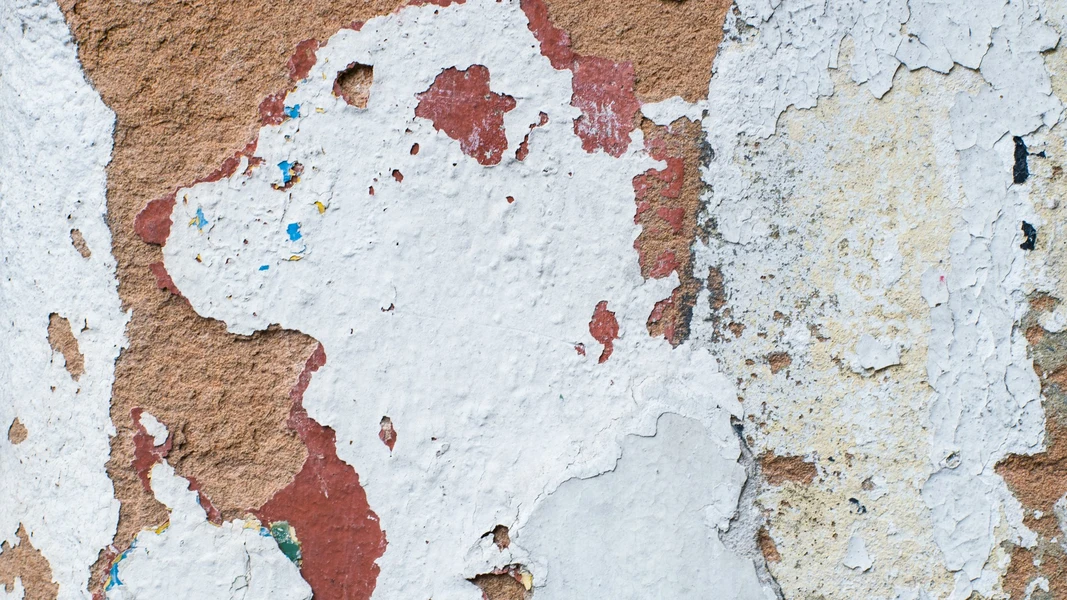Damp walls in solid brick or block structures often appear discoloured or stained, with patches of darker or lighter hues. The paint may “bubble” and easily peel away, revealing a damp surface underneath. Underneath the paint, the plaster will also crumble easily.
When you touch the walls, they may feel cold, clammy, or wet to the touch – almost like a damp towel or rag. Sometimes, there’s even a musty smell in the air, indicating the presence of mould or mildew.
These signs collectively suggest that moisture has penetrated the walls, leading to dampness and potential structural issues if left untreated.
Myths & Facts
Several misperceptions about damp walls exist. Here are some of them, along with the actual facts.
1. “Damp walls only occur in older buildings”
Any building, new or old, can develop damp walls.
Besides, the majority of the older buildings in Uganda (from the 70s and earlier) don’t face the issue of rising damp in their walls. Among other things, this can be attributed to the widespread use of Ordinary Portland Cement (OPC). For a long time, this was the only type of cement available on the Ugandan market.
Presently, there are two main types of cement on our market:
Ordinary Portland Cement (OPC)
It contains mainly calcium silicates (a mixture of limestone, clay, and other materials) and is commonly used in mortars and concrete mixtures. Renowned for its strength and durability, OPC is often used for Reinforced Concrete (RC) structures, precast concrete products, concrete pipes, concrete blocks and high rise buildings.
In Uganda, Ordinary Portland Cement is more costly than PPC.
Portland Pozzolanic Cement (PPC)
This type of cement contains pozzolans such as fly ash which reacts with calcium hydroxide to form additional cementitious compounds. Owing to its lower heat of hydration, this cement is ideal for gigantic concrete structures such as dams, and bridges, as it reduces the risk of thermal cracking.
When it comes to damp walls, OPC gives you an advantage.
Ordinary Portland Cement has hydraulic properties that allow it to cure and harden even in the presence of moisture, making it more suitable for applications where dampness is a concern, such as in basements or areas prone to water infiltration. Additionally, Portland cement-based mortars typically provide greater strength and durability, which can help mitigate the effects of dampness on masonry structures over time.
While pozzolanic cement (PPC) can also offer good resistance against dampness, Portland cement (OPC) is more commonly used for its hydraulic properties in damp environments.
Damp walls are not a result of your building’s age. Rather, a multitude of factors, even right down to the type of cement used can contribute to your wall’s resistance to this water infiltration.
So, choose wisely!
2. “Damp walls are only caused by external factors like rain”
Rainwater is a cause of damp walls, but is not the only cause.
Typically, dampness from rainwater will affect the external walls of your building.
It normally arises due to splash-back and inadequate protection of walls from driving rain.
A combination of measures like rainwater gutters, splash aprons, weather-proof paint, etc. will curb the dampness on your external walls as a result of water from the sky above.
However, there is also groundwater – water from the ground below your building.
The “water table” is the underground level where the soil or rock is filled with water, either close to or below the surface. A high water table means that the groundwater is close to the surface, while a low water table indicates that groundwater is deeper underground.
When it rains, water seeps into the ground and eventually gets under your building.
In dry areas with very low water tables, this may not lead to anything serious, since it dries out before too long. However, in damp areas with high water tables, that ground water will find its way up the foundation and into your walls. Poor drainage systems will make it even worse.
This kind of dampness will affect not only the external walls, but also the internal walls that do not come in direct contact with the rain or splash-back.
Therefore, damp walls can be caused by rainwater, but further assessment is needed to confirm that groundwater is/isn’t an additional factor at play.
3. “Damp walls will naturally dry out on their own without intervention”
If the cause of dampness is temporary/seasonal (e.g. rainwater), it is possible for the walls to dry out without intervention. However, there’s a cost.
With repeated, extended exposure to dampness, pozzolanic cement (PPC) degenerates.
Your plaster will crumble, and your paint will bubble and begin to peel off.
As this gets worse, your intervention will be inevitable, lest your building looks ragged.
Furthermore, damp walls can contribute to the deterioration of building materials, leading to structural damage and potentially compromising the overall safety and integrity of your building.
It’s best to eliminate any dampness right from the construction of your building.
However if yours is already complete and you’re beginning to see the first signs of damp walls, identify the cause and deal with it immediately. You’ll save yourself considerable sums, spent on large-scale repairs in the future.
4. “Painting over damp walls will permanently solve the problem”
Just like putting makeup over a cut does not heal the wound, painting over damp walls does not solve the underlying problem.
Fresh paint temporarily hides the damp walls, but does not address the root cause. Therefore, because the movement of water in the plaster has not been affected, the new coat of paint will also eventually blister and begin to peel off.
Once more we say, you’re better-off identifying the root cause of your damp walls than just covering it up.
5. “Damp walls are harmless and only affect aesthetics, not health”
Damp walls can have several adverse effects on the health of a building’s occupants, including promoting the growth of mould, mildew, and fungi, which can release allergens and irritants into the air, leading to respiratory issues such as asthma, allergies, and other respiratory infections.
Takeaways
- Any building, new or old, can develop damp walls.
- Rainwater is a cause of damp walls, but is not the only cause.
- Always identify and address the root cause(s) of damp walls.
- Ignored damp walls will compromise the look, health and safety of your building.
Common Mistakes
The common mistakes made by contractors when dealing with damp walls normally revolve around a failure to correctly identify the root cause of dampness, and instead addressing the “branches”.
- Application of waterproof coatings or sealants, without addressing underlying issues
- Use of inappropriate materials and techniques, leading to further damage
- Neglecting to properly dry-out the walls before applying new finishes, thus recurring dampness
Insights From the Field
In the 90s, we worked on a project at the Owen Falls Dam in Jinja, for a Chinese contractor.
We were labour subcontractors for five housing units.
In the foundation of each wall, bitumen was poured and set, before the slab was cast above it.
That was surely a water-tight plan. Of course it was costly, considering the total number of housing units under construction, but it worked! Damp walls were never an issue.
However, one can’t always blame poor workmanship for damp walls.
Even when built by the book, sometimes the bricks/blocks still absorb moisture from the ground.
Over the years, we have seen that you can backfill, use DPM, pour concrete on top and cover the entire floor, lay DPC, then start brickwork on top of that. The water still gets through all those layers and into your walls.
In addition to efficient drainage and the above-mentioned standard practices undertaken to fight damp walls, we can recommend 3 things that will be valuable assets in your fight.
1. Waterproof Cement
This is made by mixture of cement/mortar with waterproofing compounds such as Dr. Fixit.
This will seal-off your walls from rainwater and splash-back, controlling one cause of damp walls.
Except external walls exposed to rainwater, this is also recommended in the cement and mortar of bathrooms, showers, kitchens, and any rooms where splashing and runoff water is a constant factor.
2. Portland Cement in Foundations & Lower Parts of Walls
We discussed earlier about how the hydraulic properties of OPC give it superior results in damp environments. We therefore recommend that you use this type of cement in your foundation, and at least up to the first meter of your walls.
In Uganda, OPC is more costly than PPC, but you will reap the benefit for a long time to come.
3. Grooves on Walls
We recommend cutting a groove in the plaster on one side of each wall. This groove should be above floor level and should penetrate to the underlying brick/blockwork. It doesn’t need to be wider than 6mm.
Its purpose is to provide a vent for moisture in the future so that instead of rising it can exit at a lower level. The groove breaks the chain (capillarity) of the wall’s dampness – when the damp is in the plaster or brickwork.
Add these 3 recommendations to the standard practices, and you will have walls that can stand up against dampness!
Have you experienced damp walls before? How did you resolve it? Share your comments below!
Do you have damp walls as a result of groundwater? We will soon share a guide on how to repair those parts of your walls. Look out for it!
Or, consult our experts to assess the root cause(s), and professionally address your damp wall issues.



